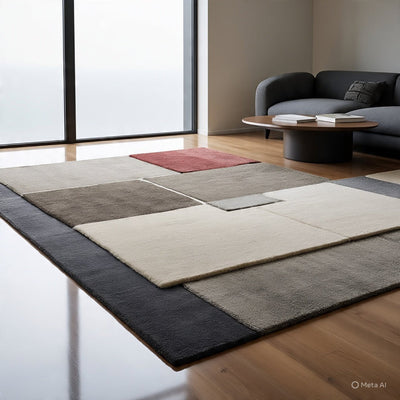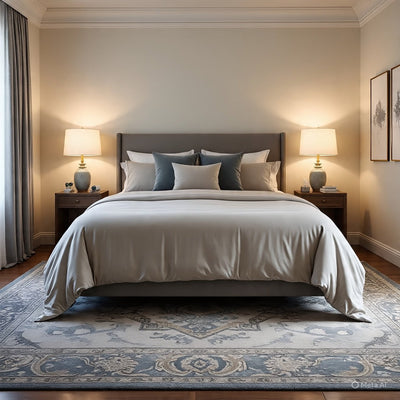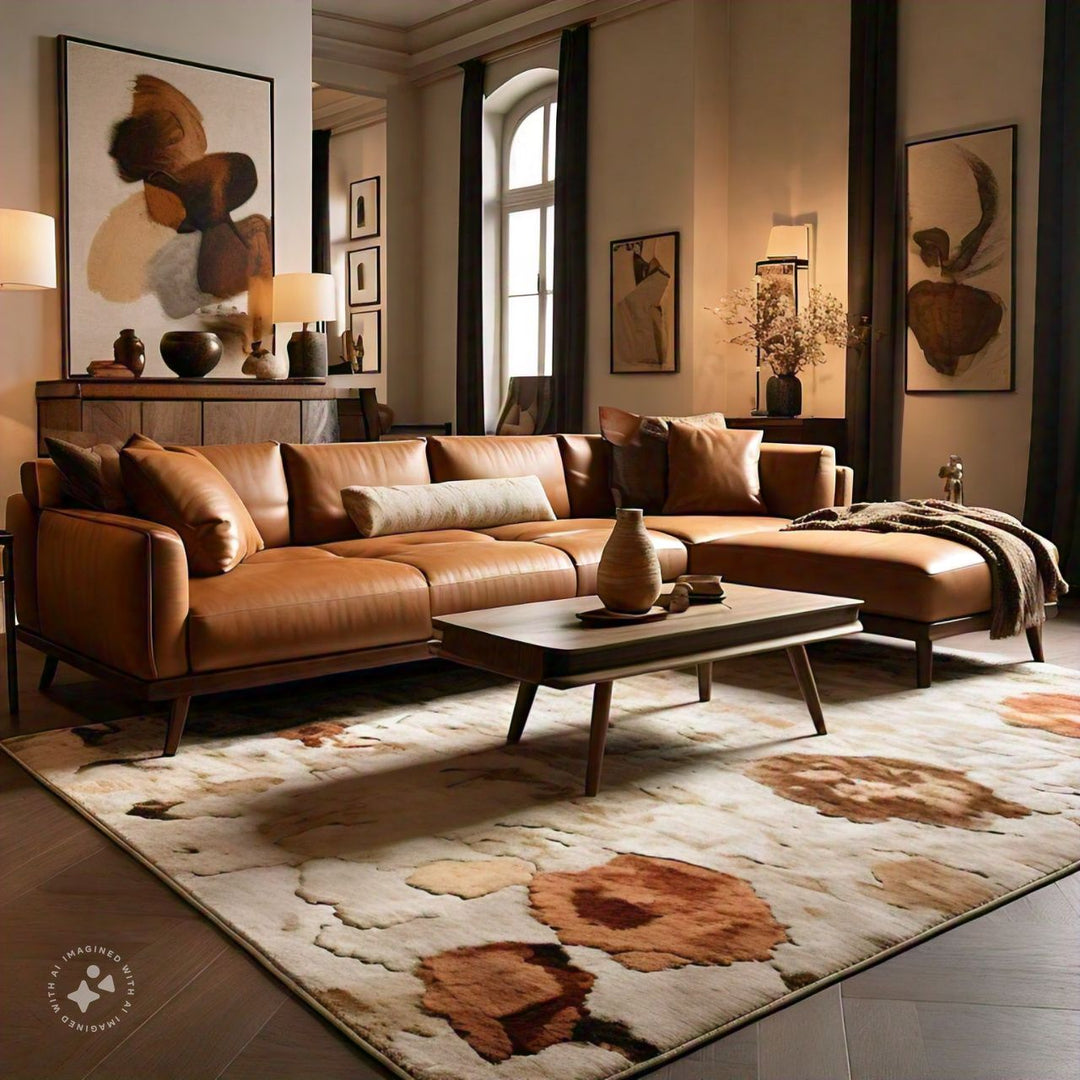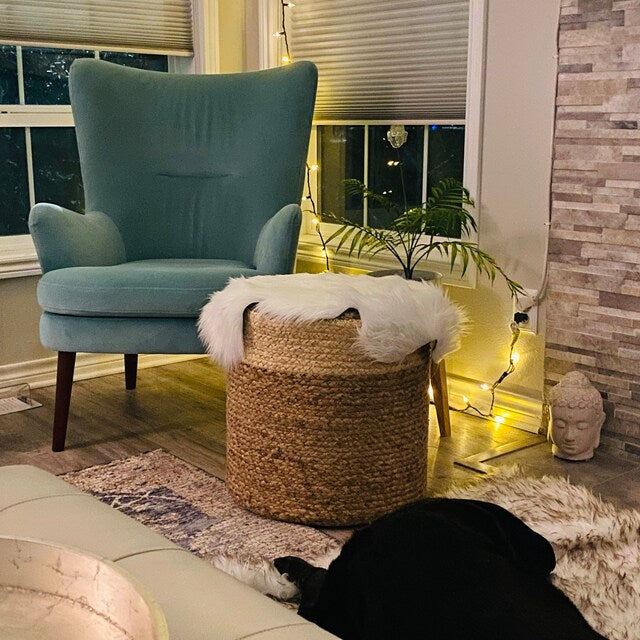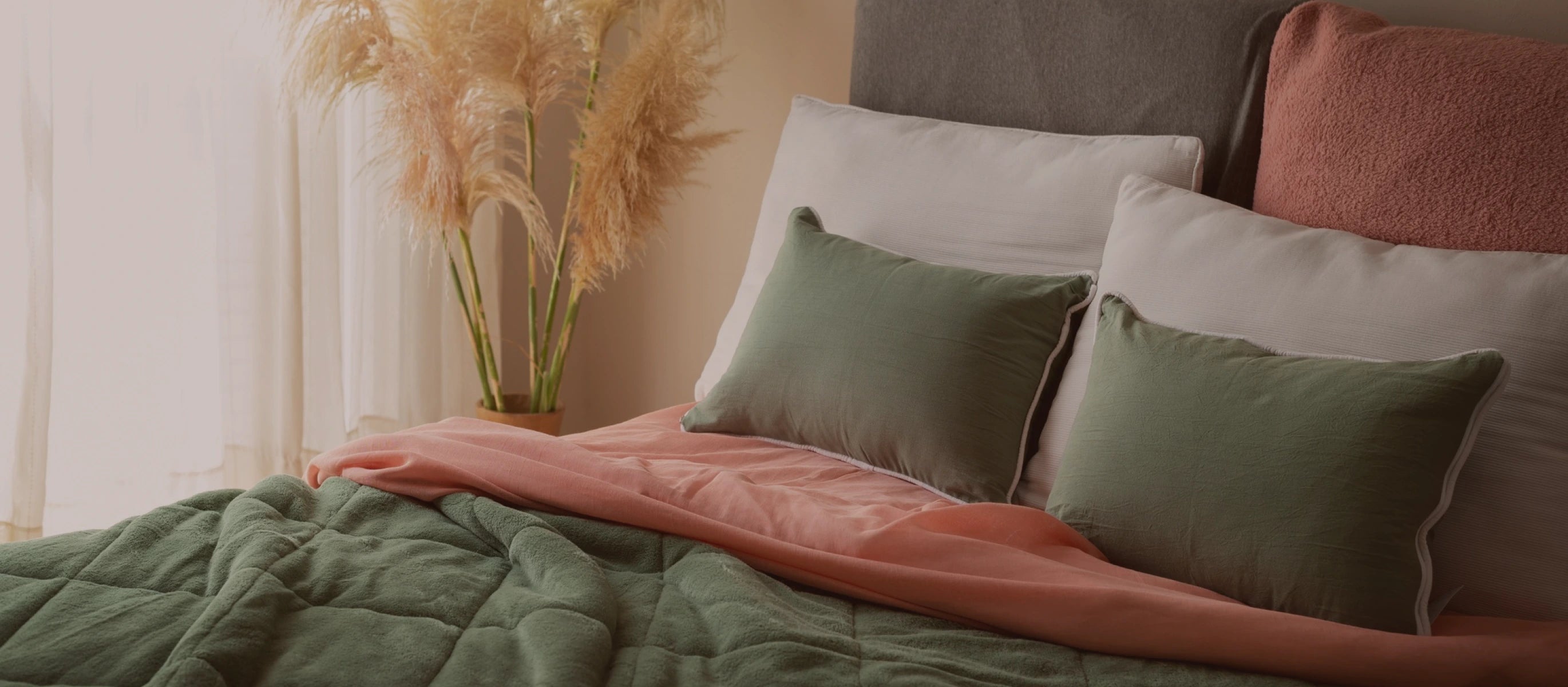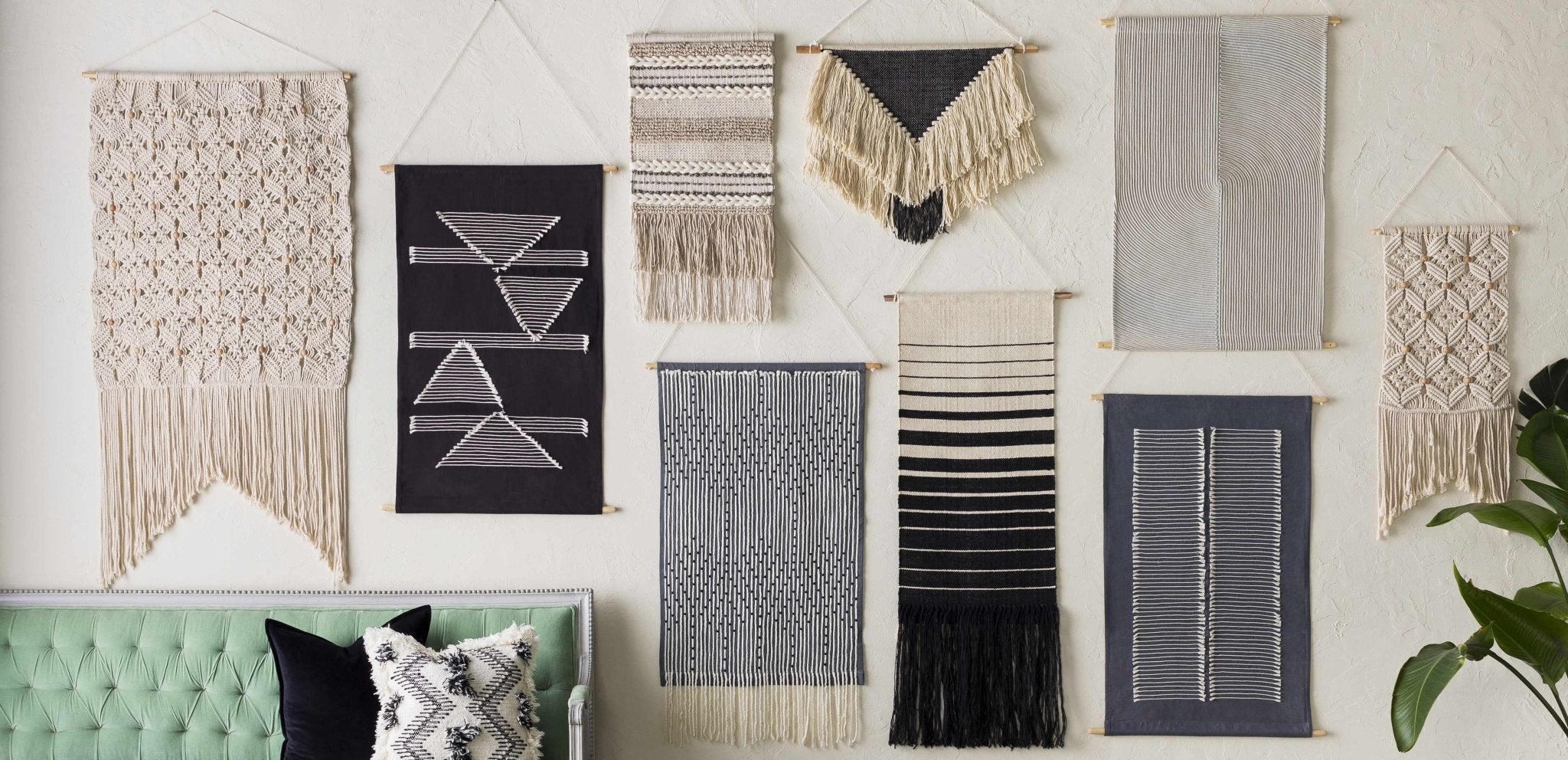How to Place a Rug in a Living Room: A Complete Guide
A well-placed rug can transform your living room by defining zones and visually amplifying your space. For instance, anchoring it to furniture, such as placing the front legs (if not all) of the furniture on the rug, helps balance the room. Follow this guide to determine the ideal rug sizes for your distinctive living room layout.
Master the art of placing a rug in your living room, why it matters, and the dos and don’ts, with this detailed guide.

Why Rug Placement Matters in a Living Room
Here are three simple reasons explaining why appropriate rug placement matters in a living room.
Makes Your Room Feel Put Together
A rug can effortlessly bring together a room and other elements, such as lighting and furniture. For instance, an oversized rug offers a large, immersive floor covering. Our experts recommend pairing it with a sectional sofa and coffee table for a grouped, cohesive look.
Helps Separate Different Areas in the Room
A rug can help define zones in a home, especially open-plan spaces. You can place a rug under the sofa to mark the seating area. Use another under the dining table to make it stand out. The rug will make each large or multifunctional area feel unique, yet coordinated.
Can Make Your Room Look Bigger or Smaller
The way you align a rug can influence the visual size of the room. Placing a narrow, rectangular rug in a large, long room can make the space appear stretched. On the contrary, rugs that run slightly past the front legs of the furniture, in a small room, can make it seem bigger.
Know Your Space Before You Place the Rug
Before placing a rug in any room, take time to understand your interiors.
Measure the Room Dimensions
A rug that is too small may look out of place or insignificant in the living room. On the contrary, an excessively large rug in a small room can overwhelm the space, even fold at the walls. It’s why measuring the length and width of a room is important. It will help you find the ideal rug size to place in your living room.
Also Read: How to Measure a Rug and Choose the Right One for Any Space?
Analyze the Room Shape and Layout
The rug you pick must complement the shape and layout of your room. For example, you could center a large, square, or round rug in a square-shaped living room. The idea is to align the rug with the main seating arrangement. Place it in a way that all, or at least the front legs of the furniture, rest on it. Doing so creates a balanced and cohesive look.
Plan Around Furniture and Foot Traffic
Before placing a rug in your living room, ensure the space around your furniture won’t get crowded by the rug. This can make it look too cluttered, especially if it’s a small space. Additionally, ensure that pathways are kept clear for movement to prevent tripping hazards. You want your space to look aesthetically pleasing while also being highly functional.
Key Rug Placement Rules to Follow
There are some common rules interior designers follow for rug placements. Apply them to your living room and watch it transform.
Front Legs On Placement: A Casual, Flexible Look
Follow this rule if you have a smaller living room. Anchoring a living room rug with just the front legs of furniture can visually connect the seating pieces, like your couch. The style choice also keeps the room more adaptable. The placement idea works best for smaller spaces because it does not require a large rug. This rule applies particularly well to furniture items such as sofas, accent tables, and chairs.
All Legs On Placement: A Cohesive, Grounded Feel
This placement rule is better suited for creating dedicated zones in larger rooms. For instance, zoning in open spaces keeps furniture, like the coffee table, organized. You can do this with custom-sized rugs that are tailored to fit any space. Furthermore, custom-sized rugs offer a unique fit and can optimize the space in irregular room layouts like open-concept settings. When personalizing the rug, ensure its size is generous enough to fit the furniture on top of it comfortably.
Keep the Rug Centered Under the Coffee Table
Placing a rug under the coffee table never goes out of style. This helps visually to organize the space. The combination draws attention to the center of the seating arrangement. When centered under the coffee table, it introduces warmth and character and provides a soft underfoot. This makes the space more comfortable. The centered approach also prevents the rug from looking disjointed in the room.
Also Read: How To Get Coffee Out Of The Rug?
Leave Even Space Around the Rug for Balance
In addition to placing a rug under furniture pieces, maintain an even border of floor space around the rug for visual symmetry. But you must avoid oversized rugs that overwhelm the living room. Leave at least 8” - 24” of exposed floor between the rug’s borders and the walls. If the room is small, opt for lighter shades, like a beige rug, to keep the space open and airy.
Use Rug Layering to Elevate Your Room’s Style
You can make your space more creative with rug layering. Layered rugs are contrasting in nature. The combination can enhance the textural depth of your living room’s decor, making it cozy and stylish. For example, a coffee table is functional and a stable element in most living rooms. You could center it on a layered rug to complement its mixed textures. This introduces depth and personality to your living room.
Rug Placement Based on Your Living Room's Shape
Based on the living room’s design, here are the best rug placement ideas to help inspire your selection.
Rectangular Living Rooms
If your living room has a rectangular layout, use a rug that runs parallel to the longest wall. The rug can elongate the space. Additionally, it will anchor the main furniture pieces, making the space feel more cohesive and inclusive. Also, you can use a runner rug in the living room as it is long and can define narrow seating areas. This makes it functional despite its compact nature.
Also Read: What is a runner rug, and everything else to know about it
Square Living Rooms
A square rug pairs well in a square-shaped living room. The rug can enhance the room’s natural symmetry and harmonize it. But you can even break away from the boxy nature with round rugs, as they have an accenting nature. This can soften angles in a square, even-sided living room.
L-Shaped or Open Concept Spaces
The way you place a rug in an open or L-shaped room will influence how spacious, dynamic, and organized the space feels. For example, a modular, L-shaped sectional sofa can securely anchor a compact, decorative round rug. The combination helps define the zone and makes the space feel cohesive.
How to Place a Large Rug in Your Living Room
A large rug works well in spacious living rooms as it fully anchors the seating area. The legs of all your furniture should sit on the rug to unify the room. Also, leave about 8” to 16” of floor space between the rug and walls, to frame the room.
How to place a Small Rug in Your Living Room
Small rugs can transform your living room, whether it’s compact or spacious, into a stunning visual statement. Here’s how!
For a compact living room with independent furniture such as a coffee table or pouf, center the rug under it. This will define a cozy focal point.
For a spacious living room, create sections for each area using small rugs. For example, if your reading nook is part of an open-plan concept, create a layered look with a small rug. This will make it stand out from the rest of your seating area.
Choosing the Right Rug Size for Your Layout
Follow this guide to find the appropriate rug size and placement for your living room.
Small Living Room
Two rug sizes work well for small living rooms. Each has unique benefits.
- 5’x7’: This rug size defines compact seating arrangements, and sits well under a coffee table or between two chairs.
- 6’x9’: The slightly larger dimension of this rug size offers additional coverage in small rooms. It allows the front legs of sofas and chairs to rest on the rug.
Medium Living Room
An 8’x10’ rug gracefully grounds a medium living room, allowing all front furniture legs to sit on the rug. What you get is a stage that allows you to create a harmonious and welcoming seating arrangement. The rug size will also leave a generous border of exposed flooring, breathing openness into the room.
Large Living Room
In a large living room, our experts at The Rug Decor recommend rugs above 9 feet and above, in length and width as the optimal size.
- 9’x12’: The rug will accommodate most or all of your furniture to render a unified and luxurious seating zone. The size is perfect for open-plan layouts, especially when you need to split two areas visually.
- 10’x14’: Use this rug size if your room is expansive. It will accommodate all your furniture and leave a visible border of flooring. So every time you walk into the room, you will appreciate its proportion and luxury.
Common Rug Placement Mistakes to Avoid
Here are some common mistakes to avoid to ensure your rug placement perfectly syncs with your furniture and living room.
Rug Too Small for the Furniture
Smaller and lightweight furniture, such as poufs or ottomans, will wobble when placed on a small rug. Ensure the rug is large enough to accommodate the furniture comfortably. For bigger and heavier furniture like a dining table set, the rug should extend beyond it by about 24”. This lets the chairs move freely when pulled out.
Misaligned or Off-Centered Placement
A rug that is misaligned or off-centered can mess with the symmetry of the furniture and the room. Even if every arrangement is perfect, this unevenness will disrupt the visual balance. Go the extra mile to align the rug with the room’s architecture and furniture.
Ignoring the Shape of the Room
The shape of the room influences the placement of the rug. For example, a square rug placed in the center of a square room will mirror the room’s geometry. Whereas, for a rectangular room, a rectangular rug will embrace the length of the room with grace. Failure to consider the shape of the room will result in a lack of spatial harmony.
FAQs
How to Place an Area Rug in a Living Room?
In a smaller living room, see that the front legs of the furniture anchor the area rug. For a larger room, use rugs of proportionate size to accommodate all legs.
How to Place a Round Rug in a Living Room?
A round rug centered under a circular coffee table creates a distinctive focal point. Additionally, if your furniture has rounded edges, a round rug will complement its curves. They also work well when aligned under chandeliers suspended from high ceilings.
How Far Should a Rug Go Under a Sofa?
As a general rule, rug placements under the sofa should extend beyond its front legs, with about 3 to 8 inches of rug visibility. This will give it a flowing look, without any awkward cut-offs.
Should all Couch Legs be on the Rug?
For a large rug, yes, all the legs of the couch can sit on the rug. However, for a small to medium rug, only the front legs can sit atop it. This gives a polished, designer-inspired look.
How Close should a Rug be to a TV?
When placing a rug in the living room, ensure it stops short of reaching the television unit. A gap of about 3” should suffice, as this placement can visually connect the seating area to the television.

